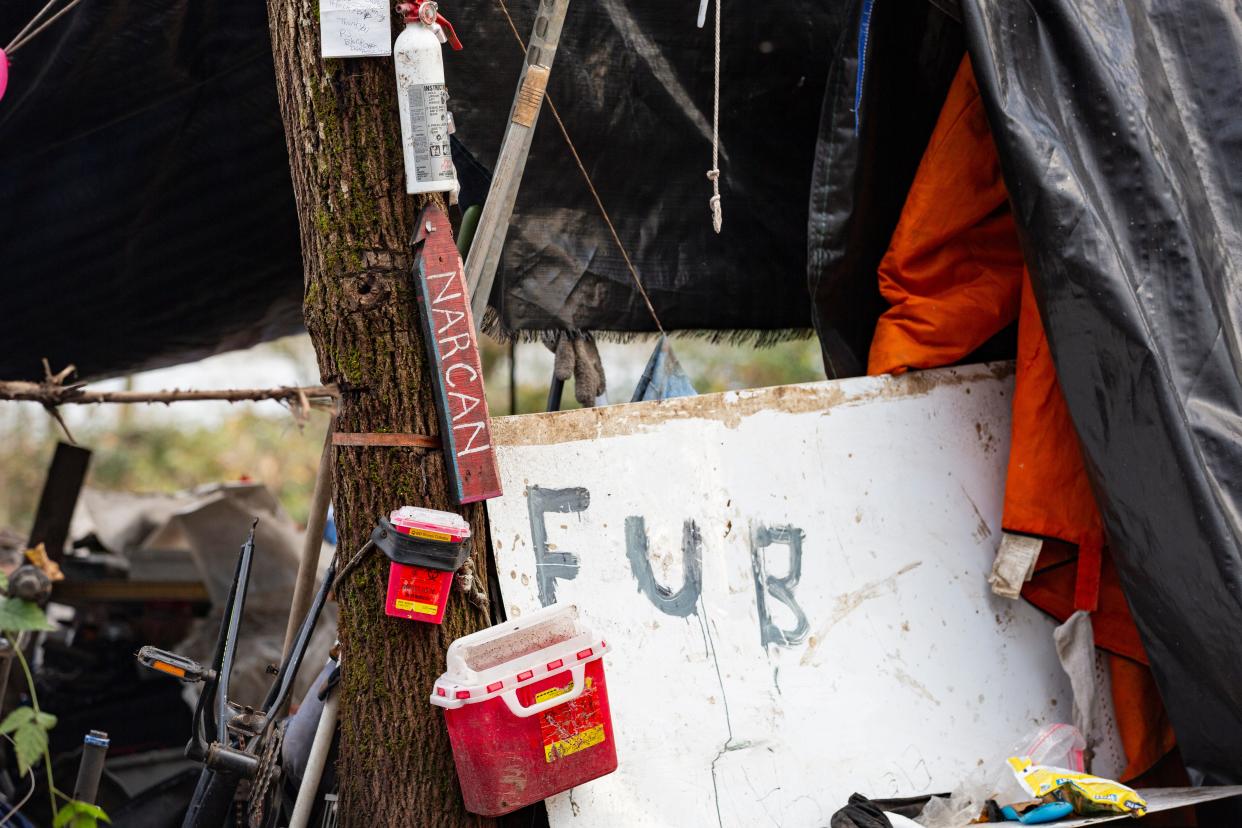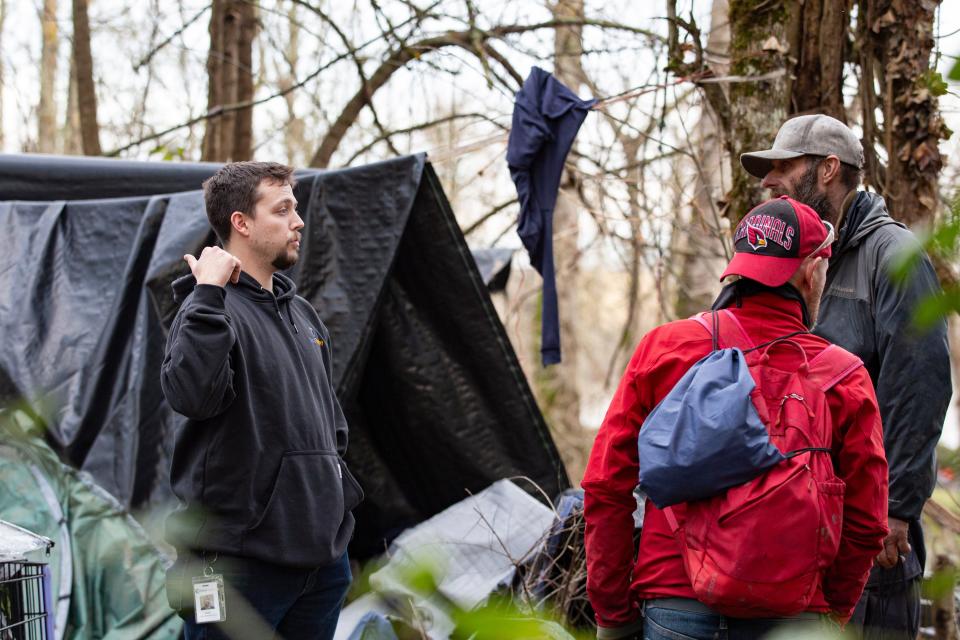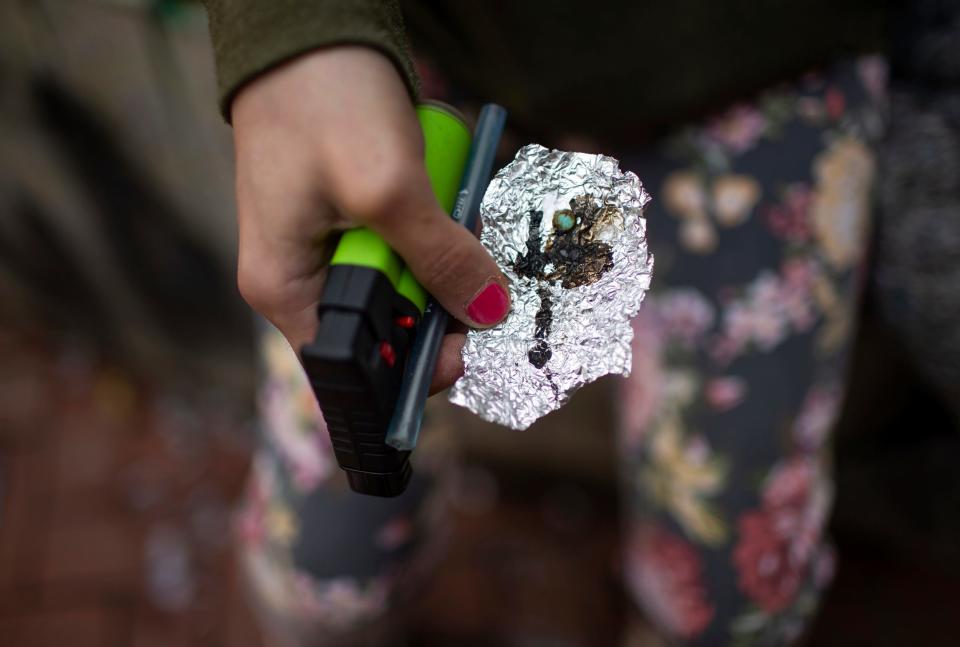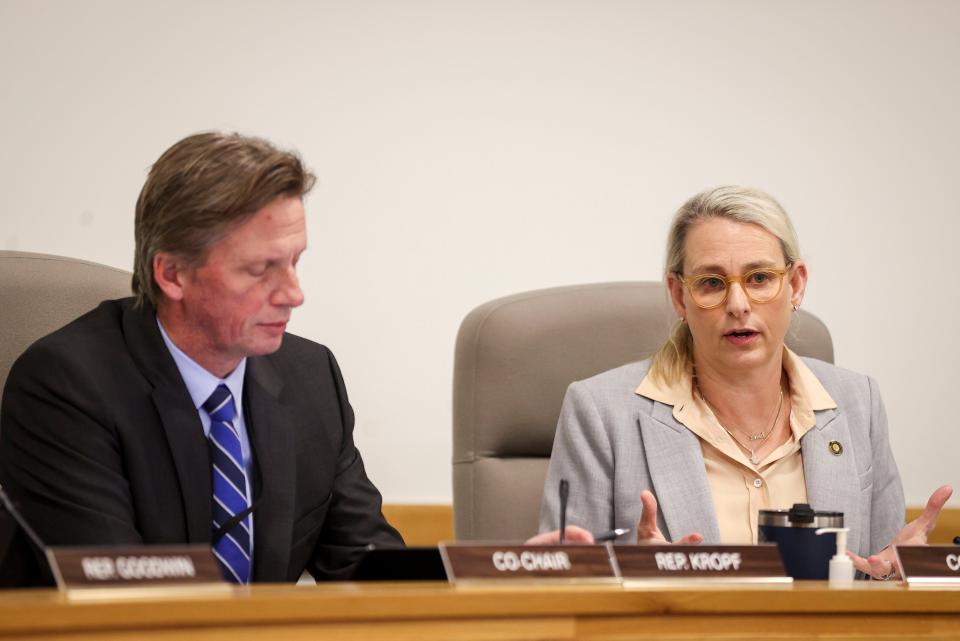Oregon lawmakers appear committed to walk back decriminalization of drugs

- Oops!Something went wrong.Please try again later.
Democrat and Republican lawmakers appear committed to walk back decriminalization of drugs as the 2024 legislative session begins Monday, despite requests from recovery service providers to stay the course.
Whether Oregon recriminalizes possession, epidemiologists warn the state may be seeing just the beginning of fentanyl's impact on overdose rates, citing trends in neighboring states and across the country. The increase in fatal drug overdoses, researchers say, is not scientifically linked to decriminalization.
Measure 110, the voter-approved decriminalization of drugs and redirection of marijuana tax revenues to substance use treatment, went into effect nearly three years ago. Its passage made Oregon the first state in the country to decriminalize possession of hard drugs.
An Emerson College survey last August of 1,000 Oregonians found 56% of Oregonians would prefer a repeal of Measure 110. The survey also found 64% of those asked said they would support a return of criminal charges. The poll has a margin of error of plus or minus 3%. It was commissioned by the Foundation for Drug Policy Solutions, an organization historically opposed to legalization of marijuana and drug decriminalization.
There were nearly 1,000 overdose deaths in Oregon in 2022, according to a January update by the Oregon Health Authority. Data for 2023 was still incomplete, OHA said, but opioid overdose visits to urgent care centers and emergency departments were higher than in previous years.
Critics of Measure 110 say it did little to incentivize drug users to seek treatment. Those stopped for possessing a small amount of drugs receive a $100 citation. The citation can be dismissed if the person calls a 24-hour hotline and goes through an addiction screening within 45 days of receiving the ticket. If they don’t, there is no punishment for not paying the citation.
State auditors reported just 1% of those who received citations in the first year after the law took effect called the hotline. During the first 15 months Measure 110 was implemented, the hotline had a total of 119 calls, auditors wrote.
In a committee hearing last month, lawmakers were told the hotline was yet to yield significant results. “Few people are calling the hotline and as a result, it costs over $7,000 per call,” Ian Green, an audit manager with the Oregon Secretary of State audits division, said.
Gov. Tina Kotek declared a fentanyl state of emergency last week in Portland alongside Portland Mayor Ted Wheeler and Multnomah County Chair Jessica Vega Pederson. The order establishes a command center downtown to direct resources and triage people addicted to fentanyl.
“Our country and our state have never seen a drug this deadly addictive, and all are grappling with how to respond,” Kotek said in a statement.

Pervasiveness of fentanyl in the West blamed for increased overdoses, not Measure 110
Researchers say there is no evidence that Measure 110 is to blame for the rise in drug overdoses.
In September, the American Medical Association published a study by the NYU Grossman School of Medicine looking at 13 states with similar drug overdose rates in the three years before Measure 110 was implemented and the first year after it went into effect. The researchers concluded there was no evidence of a tie between legal changes and fatal drug overdose rates.
And in a Measure 110 symposium last month, researchers again said while overdose rates have risen in Oregon, there is no evidence to support a direct correlation between the measure and fatal overdoses.
Fentanyl entered the drug market in different states at different points over the past decade, with Oregon being one of the last, said Alex Kral, an epidemiologist studying drug use at the Research Triangle Institute.
In the Northeast, South and Midwest, fentanyl-related deaths began to rise in 2014 before “leveling off” eight years later in 2022, Kral said. In the West, overdose mortality rates began rising in 2020 during COVID-19 and a year after fentanyl made its way to the region, with fentanyl accounting for a majority of opioid overdose deaths.
“If Oregon behaves much like these other regions, we have many more years, potentially, of things going up. I don’t think we’re at the top here and that’s the sobering part … we’ve got, unfortunately, more deaths coming,” Kral said.

Brandon del Pozo, an assistant professor at Brown University, said in a study under review, there was no association between Measure 110 and fatal drug overdoses.
Del Pozo said he and his coauthors looked at Centers for Disease Control and Prevention data and National Forensic Laboratory Information System data from the Drug Enforcement Administration to determine when fentanyl made its way to Oregon and its impact on overdose mortality.
They adjusted for the rise in fentanyl and found Measure 110 had no impact on overdoses.
He said the research was spurred after the release of a different study published in the Journal of Health Economics that found decriminalization caused 182 additional unintentional drug overdose deaths in 2021.
"What about fentanyl?" del Pozo said. “If you’re going to look at the effect of decriminalization on overdose in Oregon, it behooves you to look at the effect of fentanyl on the death rate."
"Nationally, over time and virtually in every state, fentanyl is intimately linked to overdose,” he said. “In Oregon, unfortunately, it was the same quarter you decriminalized.”
Del Pozo also said Washington state's fatal overdose rate continued to rise despite walking back its decriminalization of drugs.
What Oregon lawmakers are proposing to change on Measure 110
Lawmakers, responding to what they say is a significant concern with curbing public use of drugs and law enforcement requests for additional tools, are poised to make changes.
Two proposals would make possession of drugs different misdemeanors.
Democratic co-chairs of a committee tasked with introducing policy responding to the state’s addiction crisis are sponsoring House Bill 4002. The bill would make possession a Class C misdemeanor, carrying a penalty of up to 30 days in jail and a $1,250 fine. It also would require an offer of treatment before prosecution moved forward - essentially go to treatment or go to jail.
HB 4002 also would:
Ban insurers from imposing barriers for Medication-Assisted Treatment (MAT), allow pharmacists to prescribe and dispense emergency refills of MAT drugs and require the Alcohol and Drug Policy Commission to study removing additional MAT barriers.
Extend welfare holds from 48 hours to 72 hours at treatment facilities or sobering centers
Dealers would face bigger penalties for dealing in public parks and within 500 feet of treatment centers and homeless shelters.
Ensure people with a large stash of drugs could be charged and ask the court system to take a look at the criteria for pre-trial release of those arrested for the delivery and manufacturing of drugs.
Senate Majority Leader Kate Lieber, D-Portland, referred to the framework as a plan that "will get people the help they need, clean up our communities, and save lives."

Republicans say the proposal is not aggressive enough.
They support Senate Bill 1555 and Senate Bill 1588, which would make possession a Class A misdemeanor with penalties of up to 364 days in jail and a $6,250 fine.
Those caught using drugs in public could face a new charge, also punishable by up to 364 days in jail and a $6,250 fine.
Penalties for drug dealers also are enhanced.
Changes to Republican-sponsored bills also would create a crime of possessing, purchasing, making, delivering or selling a pill press with penalties of five years in prison and a $125,000 fine. For certain drug crimes, evaluation and treatment would be required.
SB 1588 also would transfer the duties of the Oversight and Accountability Council created by Measure 110 to the Alcohol and Drug Policy Commission.
Their proposals direct the independent state government agency to distribute grants to counties to disperse as needed. Nearly identical proposed changes to Measure 110 have been introduced by House Republicans through House Bill 4036.
"The Republican bill restores accountability, ushers addicts into treatment, and makes our streets clean and safe again – none of which will be achieved with the majority’s proposal," House Minority Leader Rep. Jeff Helfrich, R-Hood River, said in a statement.
Kotek said she was keeping a close eye on the proposals and encouraged focus on treatment, resources, and better outcomes.
“I know there’s a lot of focus on the criminalization, but I would hope everybody looks at this as a comprehensive package,” Kotek said.
Measure 110 advocates and drug treatment providers have rejected all the proposals, saying lawmakers are shortsighted and returning to ineffective solutions.
Reaction from providers, advocates
Oregonians for Safety and Recovery said any action to criminalize addiction is a “failure of leadership.”
“We are calling on the legislature to stop pursuing criminalization tactics that we all know will not work," said the coalition which includes the ACLU, Drug Policy Alliance, Ebony Collective Coalition, Health Justice Recovery Alliance, Imagine Black, Partnership for Safety & Justice, and Unite Oregon.
The coalition called on lawmakers to "embrace" immediate action "that will get people into housing and treatment now and make all of our communities more safe.”
The Health Justice Recovery Alliance said in a statement the proposals were “thinly veiled efforts to criminalize poverty and homelessness”
The alliance has advocated for more detox, treatment and other addiction services, including street outreach to connect people with services.
And it pointed to data released by the OHA showing a 300% increase in-service encounters, such as treatment, employment services or screenings, based on reporting from behavioral health providers funded by Measure 110.
“With every passing day we’re seeing Measure 110 funding become further integrated into our system of care,” said OHA Behavioral Health Director Ebony Clarke. “It’s important to sustain these investments at current levels so these providers can continue to provide these life-saving services and supports.”
Measure 110 established 42 behavioral health resource network providers across the state and had paid them more than $242 million as of January. In Marion County, six organizations had been allocated $18 million of Measure 110 funds to provide services.
Tim Murphy, chief executive officer of Bridgeway Recovery Services, said the debate about Measure 110 needs to recognize the referendum involved decriminalizing and funding resources that had gone underfunded for decades.
Murphy said it is still too early to see how effective Measure 110 has been.
He said he recognizes the public wants the Legislature to do something about the public use of narcotics but hopes legislators would build in opportunities to expunge records and encourage treatment.
"The previous practice that we had in Oregon for 30 years or longer was a failed practice of criminalization," Murphy said. "We don't want to return to failed policies of the past and we want to figure out how best to serve our Oregonian neighbors who are struggling with substance use disorders."
Dianne Lugo covers the Oregon Legislature and equity issues. Reach her at dlugo@statesmanjournal.com or on Twitter @DianneLugo
This article originally appeared on Salem Statesman Journal: Oregon lawmakers ready to recriminalize hard drugs

